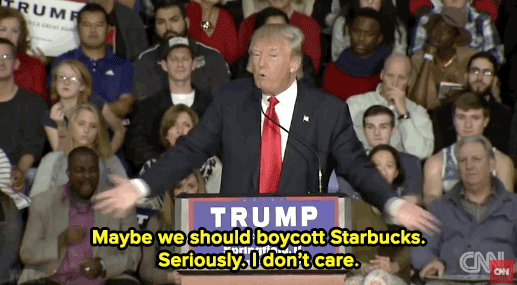Who thought a plain red cup would cause such a stir? The Starbucks cup controversy seems like a sitcom episode because there’s no way that we would let ourselves get distracted by a cup in real life, right?
On November 3, Starbucks Coffee Company held the annual release of its signature red holiday cups. Every year since 1997, the cups’ designs included holiday symbols, such as a snowman or tree ornaments. This year, Starbucks’s limited edition cup was plain red with no decoration on it whatsoever. Two days later, Joshua Feuerstein, a “Facebooker” with a huge following (yes, apparently there is such a thing as being Facebook famous), posted a video in which he claimed that the cup is an affront on Christmas. Thus, the controversy began.
Republican presidential candidate Donald Trump poured fuel on the fire by throwing a fit over Starbucks not printing “Merry Christmas” on its new limited edition cup and proposing a boycott at his campaign rally in Springfield, Illinois on November 9.

Weeks have passed since Trump’s statement, and a day still does not go by without someone mentioning the so-called controversy. After the controversy at the University of Missouri, Mizzou and in the wake of the vicious attacks in Paris and around the world, do cups even matter? CM interviewed students all over the country to see what they thought of the cups, and the answer is almost unanimous: No one cares. Read for yourself.
“No one here cares about the cups as long as they have coffee. Everyone is preoccupied with being [overwhelmed] by school.” – Taras Shulhan, Computer Science, Boston University
“I think it is great and I like it. I see it as something normal. I will just grab a sharpie and start writing and drawing.” – Marlon Diaz, Film Studies, University of Colorado, Boulder
“People at my school pretty much think that purchasing a cup is not in any way an indication of one’s faith or personal beliefs. We all have bigger things to worry about.” –Taylor Hill, University of Georgia, Athens
“Right now, students at Berkeley seem to be more interested in the issues that really matter – perceptions of racial issues in our culture (there was a Black Lives Matter protest recently), environmental policy and animal rights issues. I don’t think people care whether or not it says Merry Christmas … It’s not a big deal. [Politicians] don’t seem to understand a lot of things.” – Noah Jacobs, Computer Science and Cognitive Science, University of California, Berkeley
“Nobody cares here. Most people are confused as to why it’s such a big deal. A few [students] even think it’s kind of funny, actually.” – Ros Fiol, Visual Art Studies and Mathematics, University of Florida
“I have not heard anything about it except briefly on Yik Yak in which people could care less.” – Leigh Kerdyk, Communication, Tulane University
“Personally, I don’t give a sh-t. I think it’s ridiculous that people actually care about something so stupid when there are real problems in this world.” – Lauren Waldman, History and Educational Studies, Texas Christian University
“People on campus haven’t really been talking about it at all.” – Kirby Landon, Mathematics, Amherst College
There it is, straight from the students. Not only do people not care, many are actively against it. No, not the cup, but the controversy. It’s distracting us from much bigger issues facing us today. When major news outlets and stations waste primetime space on this nonsense, they take time away from what news stations should broadcast: ISIS attacks and developments, the Syrian refugee crisis and advancements in the treatment of Alzheimer’s disease. There are so many real, interesting and important stories out there; why are we wasting our time with this?
We know exactly what the controversy is, but how did a single person’s Facebook video post make such an impact? Warren Allen, Ph.D., an assistant professor at Florida State University is an expert on social media in the information age. “The red cup saga follows a recipe for viral information: It was simple, emotional and visual,” Allen said. “You can say the same thing about a lot of viral events, like the ALS Ice Bucket Challenge and the Respect for Marriage Coalition ‘red icon campaign’ supporting marriage equality. But unlike the Starbucks red cup incident, those campaigns were socially positive and meaningful. The juxtaposition with the recent terror attacks only underscored how utterly trivial the red cup debate was from the beginning.”
Ironically, Starbucks created the plain red cup to promote unity by inviting customers to create their own stories with a red cup that mimics a blank canvas. Let’s say Starbucks did purposefully take Christmas off of the cup. Is claiming that Howard Schultz, the Jewish CEO and chairman of the company, is waging a war against the holidays even a legitimate argument? I’m sitting in a Starbucks as I write this and I’m surrounded by Christmas. There is a large Christmas tree by the front of the store with cup-shaped ornaments for sale, stockings line some of the walls and windows feature more holiday décor. Let’s not forget to mention that Starbucks still sells a signature Christmas Blend. Starbucks still loves Christmas, whether the cups say so or not. #itsjustacup



















